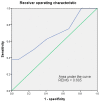Scoring Systems to Evaluate the Mortality Risk of Patients with Emphysematous Cystitis: A Retrospective Observational Study
- PMID: 36836552
- PMCID: PMC9960501
- DOI: 10.3390/jpm13020318
Scoring Systems to Evaluate the Mortality Risk of Patients with Emphysematous Cystitis: A Retrospective Observational Study
Abstract
Background: Emphysematous cystitis (EC) is a complicated urinary tract infection (UTI) characterized by gas formation within the bladder wall and lumen. Immunocompetent people are less likely to suffer from complicated UTIs, but EC usually occurs in women with poorly controlled diabetes mellitus (DM). Other risk factors of EC include recurrent UTI, neurogenic bladder disorder, blood supply disorders, and prolonged catheterization, but DM is still the most important of all aspects. Our study investigated clinical scores in predicting clinical outcomes of patients with EC. Our analysis is unique in predicting EC clinical outcomes by using scoring system performance.
Materials and methods: We retrospectively collected EC patient data from the electronic clinical database of Taichung Veterans General Hospital between January 2007 and December 2020. Urinary cultures and computerized tomography confirmed EC. In addition, we investigated the demographics, clinical characteristics, and laboratory data for analysis. Finally, we used a variety of clinical scoring systems as a predictor of clinical outcomes.
Results: A total of 35 patients had confirmed EC, including 11 males (31.4%) and 24 females (68.6%), with a mean age of 69.1 ± 11.4 years. Their hospital stay averaged 19.9 ± 15.5 days. The in-hospital mortality rate was 22.9%. The Mortality in Emergency Department Sepsis (MEDS) score was 5.4 ± 4.7 for survivors and 11.8 ± 5.3 for non-survivors (p = 0.005). For mortality risk prediction, the AUC of ROC was 0.819 for MEDS and 0.685 for Rapid Emergency Medicine Score (REMS). The hazard ratio of univariate and multivariate logistic regression analyses of REMS for EC patients was1.457 (p = 0.011) and 1.374 (p = 0.025), respectively.
Conclusion: Physicians must pay attention to high-risk patients according to clinical clues and arrange imaging studies as soon as possible to confirm the diagnosis of EC. MEDS and REMS are helpful for clinical staff in predicting the clinical outcome of EC patients. If EC patients feature higher scores of MEDS (≥12) and REMS (≥10), they will have higher mortality.
Keywords: Mortality in Emergency Department Sepsis (MEDS) score; National Early Warning Score (NEWS); emphysematous cystitis (EC); receiver operating characteristic curve (ROC); scoring systems.
Conflict of interest statement
The authors declare no conflict of interest.
Figures




Similar articles
-
Performance of Scoring Systems in Predicting Clinical Outcomes of Patients with Emphysematous Pyelonephritis: A 14-Year Hospital-Based Study.J Clin Med. 2022 Dec 8;11(24):7299. doi: 10.3390/jcm11247299. J Clin Med. 2022. PMID: 36555916 Free PMC article.
-
Performance of Scoring Systems in Predicting Clinical Outcomes in Patients with Bacteremia of Listeria monocytogenes: A 9-Year Hospital-Based Study.Biology (Basel). 2021 Oct 21;10(11):1073. doi: 10.3390/biology10111073. Biology (Basel). 2021. PMID: 34827066 Free PMC article.
-
Risk Factors and Scoring Systems to Predict the Mortality Risk of Afebrile Adult Patients with Monomicrobial Gram-Negative Bacteremia: A 10-Year Observational Study in the Emergency Department.Diagnostics (Basel). 2024 Apr 23;14(9):869. doi: 10.3390/diagnostics14090869. Diagnostics (Basel). 2024. PMID: 38732284 Free PMC article.
-
Performance of the MEDS score in predicting mortality among emergency department patients with a suspected infection: a meta-analysis.Emerg Med J. 2020 Apr;37(4):232-239. doi: 10.1136/emermed-2019-208901. Epub 2019 Dec 13. Emerg Med J. 2020. PMID: 31836584
-
Emphysematous cystitis: a review of the literature.Intern Med. 2014;53(2):79-82. doi: 10.2169/internalmedicine.53.1121. Epub 2012 Mar 1. Intern Med. 2014. PMID: 24429444 Review.
Cited by
-
A Case Study of Emphysematous Cystitis in a Non-diabetic Patient Following Empagliflozin Use: An Uncommon Presentation.Cureus. 2024 May 27;16(5):e61150. doi: 10.7759/cureus.61150. eCollection 2024 May. Cureus. 2024. PMID: 38803403 Free PMC article.
-
Better Performance of Modified Scoring Systems to Predict the Clinical Outcomes of Vibrio Bacteremia in the Emergency Department: An Observational Study.J Pers Med. 2024 Apr 3;14(4):385. doi: 10.3390/jpm14040385. J Pers Med. 2024. PMID: 38673012 Free PMC article.
-
Emphysematous Cystitis and Septic Shock: A Multidisciplinary Approach to Managing a Life-Threatening Urological Infection.Cureus. 2024 Nov 14;16(11):e73685. doi: 10.7759/cureus.73685. eCollection 2024 Nov. Cureus. 2024. PMID: 39677186 Free PMC article.
-
Atlas of patient-reported outcome measures, nomograms and scoring systems used in simple and complicated urinary tract infections: a systematic review.Ther Adv Infect Dis. 2025 Apr 11;12:20499361251328258. doi: 10.1177/20499361251328258. eCollection 2025 Jan-Dec. Ther Adv Infect Dis. 2025. PMID: 40292086 Free PMC article. Review.
References
Grants and funding
LinkOut - more resources
Full Text Sources

